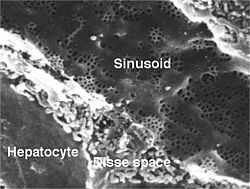Hepatocyte
| Hepatocyte | |
|---|---|
 | |
 | |
| Details | |
| Location | Liver |
| Identifiers | |
| MeSH | D022781 |
| TH | H3.04.05.0.00006 |
| FMA | 14515 |
| Anatomical terms of microanatomy | |
A hepatocyte is a cell of the main parenchymal tissue of the liver. Hepatocytes make up 80% of the liver's mass. These cells are involved in:
- Protein synthesis
- Protein storage
- Transformation of carbohydrates
- Synthesis of cholesterol, bile salts and phospholipids
- Detoxification, modification, and excretion of exogenous and endogenous substances
- Initiation of formation and secretion of bile
Structure
The typical hepatocyte is cubical with sides of 20-30
Microanatomy
Hepatocytes display an
Hepatocyte
Hepatocytes are organised into plates separated by vascular channels (
Function
Protein synthesis
The hepatocyte is a
It is the main site for the synthesis of lipoproteins, ceruloplasmin, transferrin, complement, and glycoproteins. Hepatocytes manufacture their own structural proteins and intracellular enzymes.
Synthesis of proteins is by the
The endoplasmic reticulum (ER) is involved in conjugation of proteins to lipid and carbohydrate moieties synthesized by, or modified within, the hepatocytes.
Proteins produced by hepatocytes that function as hormones are known as hepatokines.
Carbohydrate metabolism
The liver forms fatty acids from carbohydrates and synthesizes triglycerides from fatty acids and glycerol.[5] Hepatocytes also synthesize
The liver is also the main site in the body for
Lipid metabolism
The liver receives many lipids from the systemic circulation and metabolizes chylomicron remnants. It also synthesizes
Detoxification
Hepatocytes have the ability to metabolize, detoxify, and inactivate exogenous compounds such as drugs (see drug metabolism), insecticides, and endogenous compounds such as steroids.
The drainage of the
One of the detoxifying functions of hepatocytes is to modify ammonia into urea for excretion.
The most abundant organelle in liver cells is the
Aging
As mammalian liver cells age,
Society and culture
Use in research
Primary hepatocytes are commonly used in cell biological and biopharmaceutical research. In vitro model systems based on hepatocytes have been of great help to better understand the role of hepatocytes in (patho)physiological processes of the liver. In addition, pharmaceutical industry has heavily relied on the use of hepatocytes in suspension or culture to explore mechanisms of drug metabolism and even predict in vivo drug metabolism.
For these purposes, hepatocytes are usually isolated from animal or human
Additional images
-
Schemic diagram of Biliary system
See also
References
- ^ The diameter of human hair ranges from 17 to 181 μm. Ley, Brian (1999). Elert, Glenn (ed.). "Diameter of a human hair". The Physics Factbook. Retrieved 2018-12-08.
- ^ Lodish, H., Berk, A., Zipursky, S. L., Matsudaira, P., Baltimore, D., Darnell, J. E. Molecular Cell Biology (Fifth Edition). W. H. Freeman and Company. New York, 2000, pp 10.
- OCLC 663096046.
- S2CID 22708555. Archived from the original(PDF) on 2012-04-25.
- PMID 27178543.
- ^ a b Holmes GE, Bernstein C, Bernstein H. Oxidative and other DNA damages as the basis of aging: a review. Mutat Res. 1992 Sep;275(3-6):305-15. doi: 10.1016/0921-8734(92)90034-m. PMID: 1383772
- ^ Vougioukalaki M, Demmers J, Vermeij WP, Baar M, Bruens S, Magaraki A, Kuijk E, Jager M, Merzouk S, Brandt RMC, Kouwenberg J, van Boxtel R, Cuppen E, Pothof J, Hoeijmakers JHJ. Different responses to DNA damage determine ageing differences between organs. Aging Cell. 2022 Apr;21(4):e13562. doi: 10.1111/acel.13562. Epub 2022 Mar 4. PMID: 35246937; PMCID: PMC9009128
- PMID 20645046.
- S2CID 449420. Erratum in: FASEB J 1989 May;3(7):1873.
- S2CID 27593521.
- PMID 11267922.
- S2CID 4981423.
- PMID 21605667.
External links
- Histology image: 22101ooa – Histology Learning System at Boston University - "Ultrastructure of the Cell: hepatocytes and sinusoids"
- Hepatic Histology: Hepatocytes (Colorado State University

